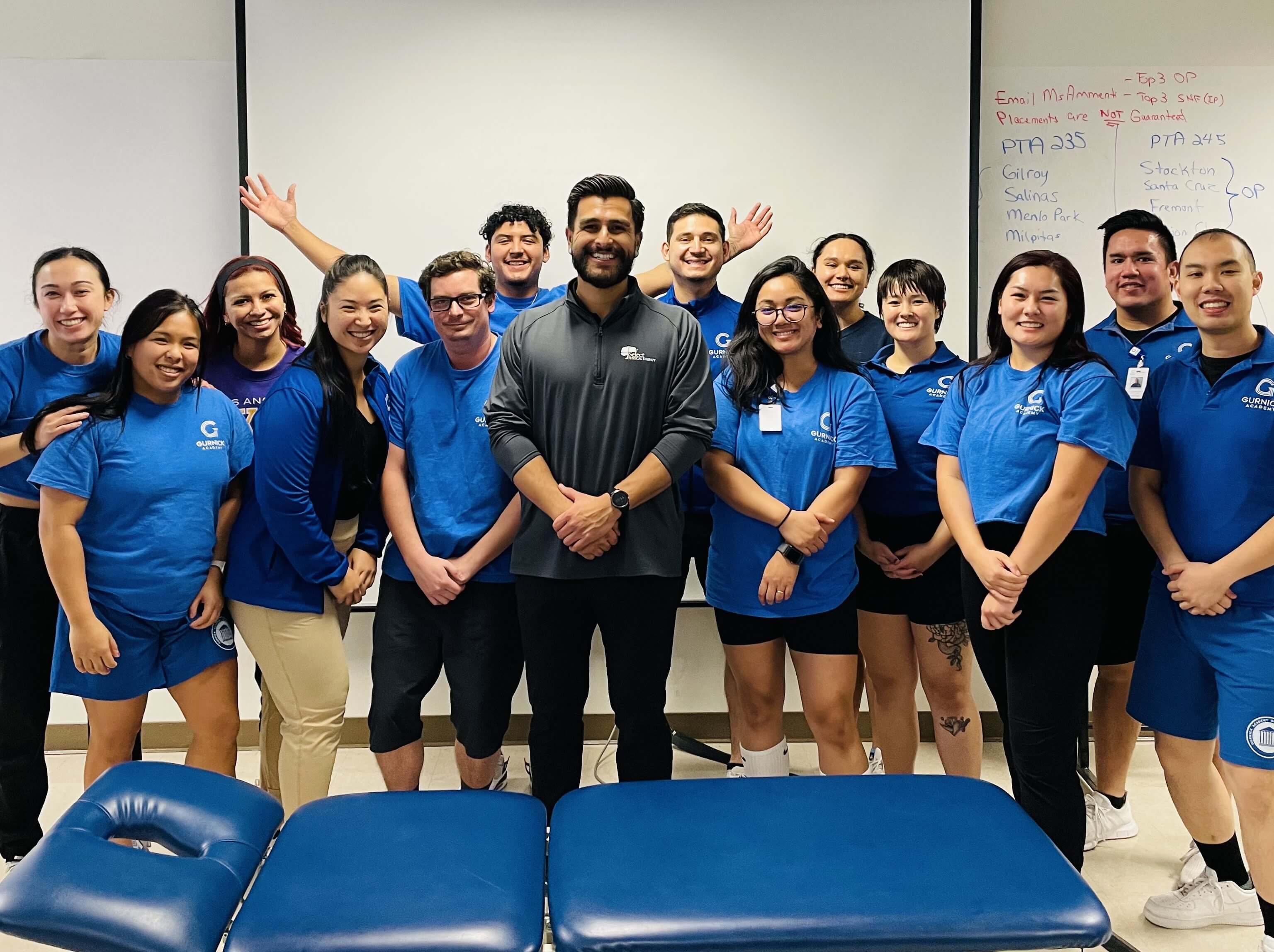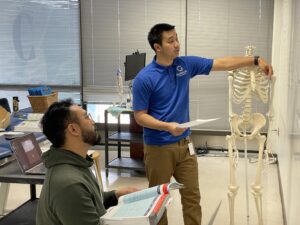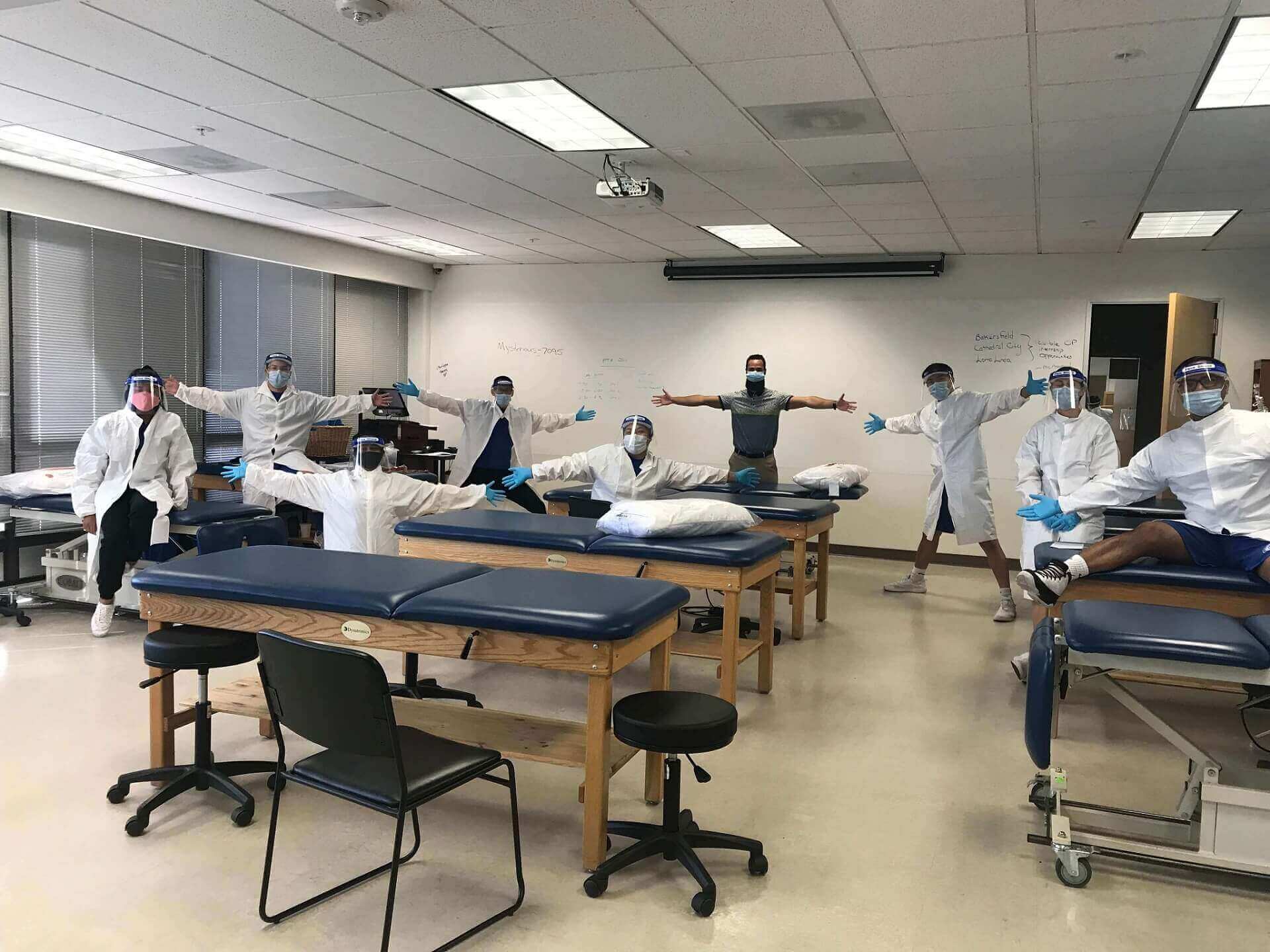Become a Physical Therapy Assistant: A.S. in PTA Program
Date: February 8, 2023
Do you aspire to work in healthcare and positively impact others’ lives? Are you interested in fitness and want to help patients work toward their health and wellness goals through skilled, functional exercise? If so, a vocation as a Physical Therapy Assistant (PTA) may be the route to pursue. Who are PTA professionals, and what do they do?
What is Physical Therapy?
Modern healthcare relies on triaging body symptoms and diseases with medication, imaging, and surgery. Physical therapy deploys a more natural and less invasive approach to treating pain and physical limitations. Together with medical interventions, PTAs can utilize a more holistic approach to treatment. The methodology includes exercise, modalities, gait and balance training, and hands-on techniques to help rehabilitate patients from an array of injuries, surgeries, and diseases.1, 2
Who is a PTA?
As core members of rehabilitative teams, PTAs help patients regain movement and manage pain after injury and illness.2 Typically, these highly-trained persons assist in administering prescribed treatment plans based on patient status, document patient progress, and report results to their supervising physical therapists.3 Ultimately, PTAs help patients achieve their individual and functional mobility goals.
Treatments often include graded exercise, targeted stretching and tissue mobilization, gait, balance, agility training, and other therapeutic interventions.2 Generally, PTA goals include helping patients lead more active lives, return to work and sports activities, and improve their overall quality of life.4
All in all, PTA professionals generally perform an array of duties. These tasks range from observing patients, implementing treatment protocols, and managing various therapeutic devices and equipment. Simultaneously they educate patients and families regarding treatments, goals, and responses.2
Where Do PTAs Work?
PTAs work in various settings, including hospitals, skilled nursing and rehab facilities, outpatient clinics, home health agencies, schools, and sports and fitness centers.5 Hours that PTAs work in a typical week vary based on the facility. Services may be open seven days a week yet are typically limited to daytime rather than evening shifts. For instance, hospitals continue therapy over weekends in reduced capacities. However, some practices offer treatment times accommodating working patients’ schedules.5
Skill Sets Needed For PTAs
Due to the profession’s range and scope, a PTA should possess an eclectic mix of soft and hard skills. Needed traits include a solid knowledge of anatomy, physiology, kinesiology, and other core sciences. Additionally, one needs competency in therapeutic interventions, protocols, patient care skills, and proper body mechanics for safe and effective treatment.
The vocation requires a PTA to master many skills. These include critical thinking, active listening, physical strength and stamina, computer literacy, and safety with operating equipment while assisting patients.5 Beyond foundational knowledge of clinical skills, a PTA should demonstrate the core values of the profession, which include accountability to patients and supervisors, compassion and caring for all patients, altruism. Equally, they should be lifelong learners, have integrity, and adhere to social responsibility for all patients regardless of background or status.
Being a PTA involves perceiving social cues while conveying information effectively. Ultimately this professional should also understand the fundamental implications for obtaining new knowledge and for problem-solving and decision-making. 3,4
How Does One Become a PTA?
To work as a PTA in the U.S., one must first graduate from a qualified PTA program, then pass a state-administered national exam.4 Generally, one commences by completing a two-year PTA program. Gurnick Academy of Medical Arts offers an A.S. in Physical Therapist Assistant program that can be completed in as little as 11 months or 80* approved instructional weeks. (This includes 36 weeks of prerequisites taken before enrollment.)
Overall, Gurnick’s PTA program strives to provide students with the necessary skills to enter the workforce as competent, thinking, respectful, and compassionate individuals. Primary content areas in the PTA curriculum should include anatomy, physiology, and exercise physiology. Coursework should also cover biomechanics, kinesiology, neuroscience, clinical pathology, behavioral sciences, communication, and ethics/values.4
Examination/Certification
After graduating from an accredited PTA program, students are eligible to sit for the National Physical Therapy Examination (NPTE® ). A passing score on the NPTE is required to obtain licensure to practice as a PTA. Many states may also need a passing score on a jurisprudence exam. Such exam tests examinees regarding content related to the specific laws and regulations of physical therapy in an individual state.
Is This a Good Profession?
According to the U.S. News and World Report, PTAs rated #3 in “Best Health Care Support Jobs” and #38 in 100 “Best Jobs.” Jobs are ranked according to their ability to offer an elusive mix of factors. These include salary, job market, future growth, stress, work-life balance, etc.6 Further, the Bureau of Labor Statistics projects a 26.5 percent employment growth for PTAs between 2021–2031. In that period, an estimated 25,600 jobs should open up.6
How Much Does a PTA Make?
According to the Bureau of Labor and Statistics, the mean annual wage for PTAs in May 2021 was $60,740.2 It’s important to remember individual salaries can range for multiple reasons, including geographical work location, years of experience, additional degrees or licensure, and place of employment.
Altruistic Benefits
Beyond income, there are altruistic benefits for those serving in this vocation. Ultimately, PTAs may have profound effects on people’s lives. Part motivator, encourager, and educator, a PTA can work with various patient populations, from pediatrics to geriatrics, amputees to athletes, and orthopedics to oncology. It is gratifying to see patients progress through physical therapy treatment. They may go from experiencing severe pain or physical disability to being able to walk, run, play, and return to work. How many jobs can see that progression?
Where Are You? Where are You Going?
A PTA profession brings with it continual lifelong learning. PTAs can increase their knowledge and skills through the APTA’s PTA Advanced Proficiency Pathways program. Specialty content areas include acute care, cardiovascular/pulmonary, geriatrics, oncology, orthopedics, pediatrics, and wound management.4 One may make a PTA profession their lifelong goal or use it as a bridge to other pursuits.
With all that this vocation offers, shouldn’t you start your pathway today? For more information about our PTA program, click here. ~
Citations:
1 Oxford Languages. “Oxford Languages and Google—English.” Oxford Languages. Oxford University Press, 2022. (Accessed Jan.30, 2023.)
2 ^a, b, c, d Bureau of Labor Statistics, U.S. Department of Labor, Occupational Outlook Handbook, Physical Therapist Assistants and Aides. (Accessed Jan. 27, 2023.)
3 ^a, b “31-2021.00—Physical Therapist Assistants.” O*NET OnLine, National Center for O*NET Development. (Accessed Jan. 27, 2023.)
4 ^a, b, c, d, e “Becoming a Physical Therapist Assistant.” APTA, American Physical Therapy Association (APTA). (Accessed Jan. 27, 2023.)
5 ^a, b, c Indeed Editorial Team.” How to Become a Physical Therapist Assistant. Indeed. August 17, 2022. (Accessed Jan. 27, 2023.)
6 ^a, b U.S. News Best Jobs. “Physical Therapist Assistant Ranks Among Best Jobs of 2019.” Usnews.com. U.S. News and World Report, L.P., 2016. (Accessed Jan. 27, 2023.)



